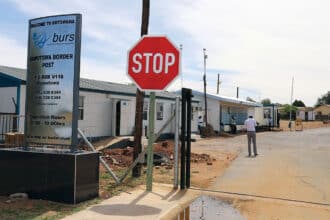OVERHEATING TYRES BLAMED FOR DEATH OF 9 STUDENTS
Parents of nine Matsha students who died in a truck accident six years ago are inching nearer to finding closure as tragic details of what caused the accident begin to emerge in court.
November 13th, 2015 will remain etched in the minds of the parents whose children’s lives were snuffed out and the nation at large as one of the bloodiest, darkest chapters in Botswana’s history.
Having just completed their Form Five exams, 122 Matsha College students were crammed into the back of a truck, packed into the rickety old vehicle like cattle as they headed home for the summer holidays.
Nine children never made it home!
The man behind the wheel on that fateful day, 44-year-old Dogi Thoomadi lost control of the truck at Dutlwe along the Morwamosu-Letlhakeng road in Kweneng District and was unable to prevent it from overturning.
Five students died at the scene while a further four succumbed to their injuries at later dates.
Last week Thoomodi appeared in court facing nine charges of causing death by dangerous driving.
Giving evidence before court, a Vehicle Examiner in the Department of Road Transport and Safety, Mogomotsi Mooketsi said he suspected the driver was speeding, which caused the tyre to heat up and ultimately burst.

“The investigating officer asked for a technical point of view from our vehicle examination office in regard to the rear left tyre of the vehicle which is suspected to be the main cause of the accident,” he explained.
According to Mooketsi, the type of rear tyres used was Apollo bullet R22 14.00-20, which he explained was better, suited to gravel or sandy roads.
“It is the type of tyre that has a poor heat dissipation characteristic, which renders it a slow speed tyre. The tyre can only be used at a maximum speed of 65km/h. This means that the tyre does not effectively cool down when it is being used on tarred roads for prolonged periods of time when one drives at high speed,” said Mooketsi.
When asked if he was able to tell the speed at which the vehicle was moving when the accident occurred, Mooketsi said the state of the tyre indicates the truck was travelling above the limit for a hard road.
“If you drive at high speed, it leads to what happened,” he reasoned.
When quizzed by the defence attorney, Temperance Ketshabile, if the driver could reasonably be expected to know the type of tyre suitable for sand or gravel, Mooketsi maintained he should.
“I expect him to know the characteristics of the vehicle he drives. For road safety purposes he had to know,” insisted Mooketsi.
He also told court the truck had a capacity to carry 56 students and thus was well over the limit.
“After measuring the load compartment of the vehicle, we found out that it had an area of about 17 square metres. For passengers to be loaded on a vehicle with an open body, each person covers an area of about 38 square centimetres as per Road Traffic Act,” he said.
Mooketsi further stressed manufacturers made trucks to carry goods not people and that it is never safe to carry people in a truck or open van.
“Yes that’s why in Japan they don’t allow people to be carried in trucks or vans,” noted Ketshabile, to which Mooketsi responded he was not conversant with Japan legislation as here in Botswana it is permitted.
The state is left with three witnesses as trial continues next month.







